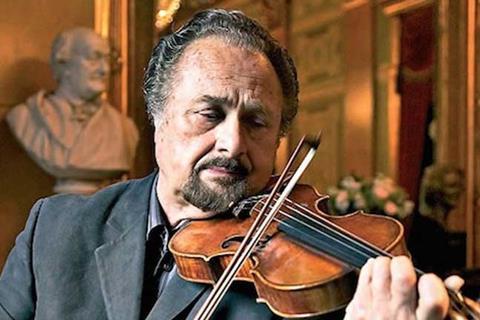The American maestro discusses the need for relaxation and finesse for good tone production in a 2007 article for The Strad

Auer stated that no hard-and-fast rule existed for how the second, third and fourth fingers grasp the bow. I hold the violin as directly centred as possible. Someone with a longer arm might have to move the violin over a couple of inches in order to always play parallel to the bridge. I hold the bow with my third finger on the eye of the frog and I usually keep it there. The hand is rounded, I’m using all the fingers. The little finger is always resting on the bow behind the third finger; it doesn’t exert pressure but balances the bow. The thumb is bent and presses on to the frog, where it rests all the time.
Much of the secret of good tone comes from control of the bow. The obsession today is with big tone. Too often the tendency is to press harder, but all that happens is that the player works harder and achieves less. The arm should not play a part in the production of tone. Sometimes I tell my students: 'Look, you’re not ironing a shirt; you’re trying to draw the sound out of the instrument, not press the tone into it.' Something has to be sacrificed when you are pressing hard like that.
Pressure actually decreases the sound. When you go past the centre of the bow and press, the bow will begin to quiver. People who bow that way are afraid of losing control of their bow and will often move rapidly away from the centre of it because they’re afraid that it will shake or that they will drop it when sustaining a long note. They also compensate by tightening the bow hair so much that there’s no longer any vibration of the stick. If the bow doesn’t vibrate it will not produce the individual sound that every fine bow can. Suddenly, the sound becomes smaller because about a third of it is being lost.
Every move of the bow has to be calculated. I often compare bowing to a game of billiards. It’s not about knocking the ball into the pocket; it’s about where you set the cue ball for the next shot. Not enough thought is given to where the bow should be for the note after the one you’re playing now.
There should be no break in the sound with the bow change. Drawing the bow to the tip, there is a light turn that corresponds to a similar turn at the frog, so it’s like a figure of eight. The result is seamless, lyric sound. People who haven’t learnt how to move the bow to the frog never quite reach the frog or the tip and play in effect with two-thirds of the bow.
Read Aaron Rosand's blogs on on how to practise effectively, correct playing posture and why violinists should avoid using a shoulder rest.
This article was first published as part of a larger feature in The Strad's September 2007 issue











































No comments yet